Creating a DIY BBQ rib rub is key to grilling mouthwatering, tender ribs at home. Combining sweet, savory, and spicy flavors like brown sugar, paprika, garlic, salt, pepper, chili powder, and cayenne enhances meat's natural juices. Balancing these elements transforms ordinary pork into gastronomic delight. Apply the rub evenly with oil for better adherence, using a brush or sprinkling directly onto ribs. Master various cooking methods—smoking then grilling—for ideal tenderness and flavor profile. Patience, slow and low cooking, and a balanced dry rub ensure fall-off-the-bone BBQ ribs on the grill.
Discover the secrets behind crafting the perfect homemade BBQ rib rub, a classic flavor profile that forms the heart of any grill dish. From understanding the essential ingredients to mastering the art of mixing and application techniques, this guide will transform you into a BBQ master. Learn how to create ribs that melt in your mouth with various cooking methods and insider tips. Elevate your grilling game with our comprehensive BBQ rib recipe designed to impress both you and your taste buds.
- Understanding BBQ Rib Rub: The Heart of a Classic Grill Dish
- Choosing the Right Ingredients for a Time-Honored Flavor Profile
- The Art of Mixing: Creating the Perfect Rub Balance
- Applying the Rub: Techniques for Even Seasoning on Ribs
- Cooking Methods: Maximizing Flavor with Various BBQ Styles
- Tips and Tricks for Achieving Fall-Off-the-Bone Ribs at Home
Understanding BBQ Rib Rub: The Heart of a Classic Grill Dish
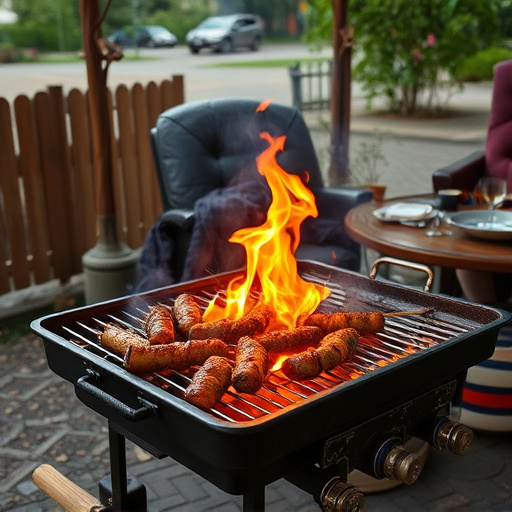
BBQ rib rub is an essential component in any serious griller’s arsenal, acting as the secret sauce for achieving mouthwatering, smoky ribs. It’s more than just a spice blend; it’s the heart and soul of a classic grill dish. When you sprinkle this magical mix over your ribs before cooking, it transforms raw meat into a tantalizing culinary experience. A well-crafted BBQ rib recipe involves balancing sweet, savory, and spicy flavors to create a rub that enhances the natural juices and tenderness of the ribs.
The beauty of a DIY BBQ rib rub is the creative control it offers. You can customize the ingredients to suit your taste preferences, whether you prefer a milder blend or one packed with heat. Common staples in a BBQ rib rub include brown sugar for sweetness, paprika for smokiness, garlic and onions for depth, salt and pepper for complexity, and various spices like chili powder or cayenne for a kick. Understanding the role of each ingredient is key to crafting a rub that elevates your home-cooked ribs to restaurant-quality levels.
Choosing the Right Ingredients for a Time-Honored Flavor Profile
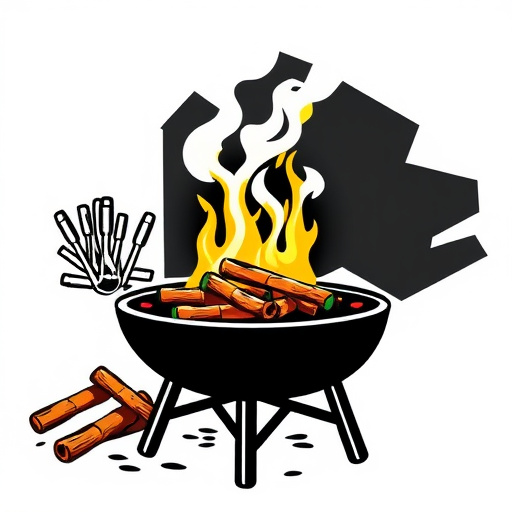
When crafting a homemade BBQ rib rub, selecting the perfect ingredients is key to achieving that classic, time-honored flavor profile everyone loves. The foundation of any good rub lies in a blend of spices like paprika, garlic powder, and brown sugar—essential for adding depth and sweetness to your ribs. Paprika brings a rich, smoky taste, while garlic powder imparts a pungent aroma that complements the savory notes. Brown sugar not only contributes to the caramelization process during grilling but also creates a delectable crust on the rib meat.
For an authentic BBQ rib recipe, consider adding coarsely ground black peppercorns for heat and crunch, as well as a touch of cayenne pepper for that extra kick if you prefer your ribs with a bit of spice. Don’t forget the importance of salt—it enhances all other flavors and ensures your ribs are succulent and tender. These classic ingredients combine to create a rub that will transform any set of ribs into a mouthwatering, grill-worthy masterpiece.
The Art of Mixing: Creating the Perfect Rub Balance
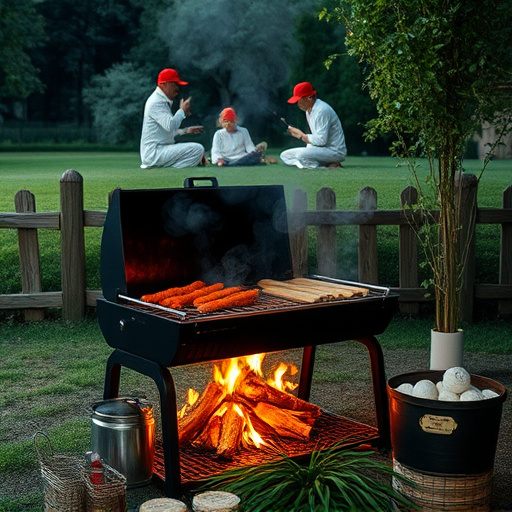
Creating a balanced blend for your BBQ rib rub is an art that combines taste and texture to elevate your grilling experience. The perfect rub should offer a harmonious mix of sweet, savory, and spicy flavors that complement the rich, smoky profile of barbecue ribs. Start by considering the classic trio: brown sugar, salt, and pepper. These ingredients form the foundation, each contributing unique qualities—the sweetness balances the heat, while salt enhances both, creating depth in every bite.
Experiment with additional spices like paprika, garlic powder, chili powder, and cayenne to add complexity. Mix these carefully, adjusting quantities based on your preference for heat and overall flavor profile. A well-blended rub will stick to the ribs, infusing them with aroma as they cook. This process transforms simple pork into a mouthwatering masterpiece, proving that the key to an exceptional BBQ rib recipe lies not just in the meat itself but in the artful combination of spices.
Applying the Rub: Techniques for Even Seasoning on Ribs

Applying the rub evenly is key to achieving a delicious, well-seasoned BBQ rib. Start by mixing your rub in a bowl, ensuring all ingredients are thoroughly combined. For best results, use a generous amount of oil to help the rub adhere to the ribs; this step ensures every surface is coated. You can apply the rub either directly onto the meat or use a dry brushing technique, depending on your preference and desired intensity of flavor.
If using a brush, gently swab each rib, focusing on both sides and the ends. For a more even distribution, consider patting the rubbed ribs with paper towels after application; this step helps to set the seasoning. If you’re not using a brush, simply sprinkle the rub generously over the ribs, ensuring it sticks by gently pressing your hand against the meat. This technique allows for a more uniform layer of flavor that will infuse during cooking.
Cooking Methods: Maximizing Flavor with Various BBQ Styles
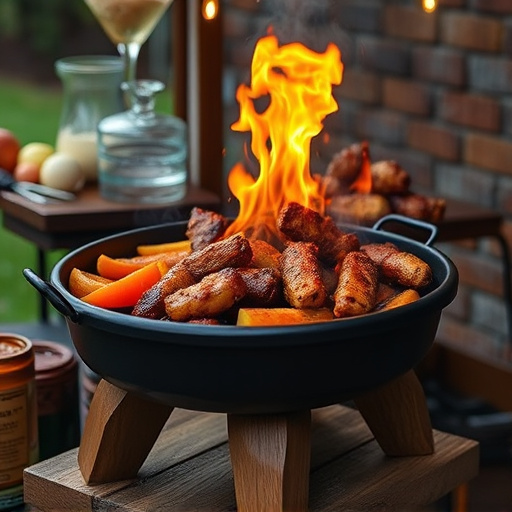
When it comes to maximizing the flavor of your BBQ rib recipe, the cooking method plays a significant role. Different BBQ styles offer unique approaches to enhancing taste and texture. For instance, slow-cooking methods like smoking involve low and steady heat, allowing the ribs to cook thoroughly and imparting a rich, smoky flavor. This process is ideal for tenderizing the meat and creating a deep, complex taste that classic BBQ rib recipes strive for.
On the other hand, grilling adds a burst of flavor through direct heat, charring the surface of the ribs and locking in juices. It’s a faster method that requires careful attention to avoid overcooking, but it can produce a delightful crust on the meat. Combining these cooking techniques—smoking first for an extended period, then finishing with a high-heat grill—can result in mouthwatering BBQ rib recipes that balance tenderness, juiciness, and an irresistible flavor profile.
Tips and Tricks for Achieving Fall-Off-the-Bone Ribs at Home
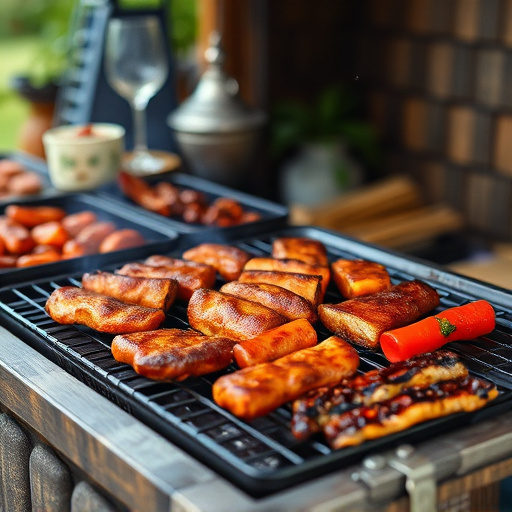
When aiming for that coveted fall-off-the-bone texture in your homemade BBQ rib recipe, there are a few key tips to keep in mind. First, patience is paramount. Slow and low cooking methods, such as those used in a grill or smoker, allow the meat to tenderize naturally over time. This means setting your grill to a lower temperature and allowing the ribs to cook gently for an extended period.
Second, don’t overlook the power of dry rub. A well-balanced BBQ rib rub with classic flavors like paprika, garlic, brown sugar, and peppercorns can significantly enhance both the taste and tenderness of your ribs. Rub the spice mix generously all over the meat before cooking, and consider coating it in foil to trap moisture while still allowing for even heat penetration.
